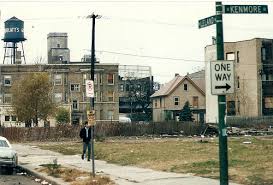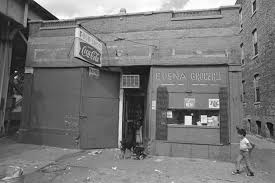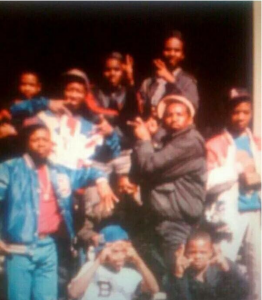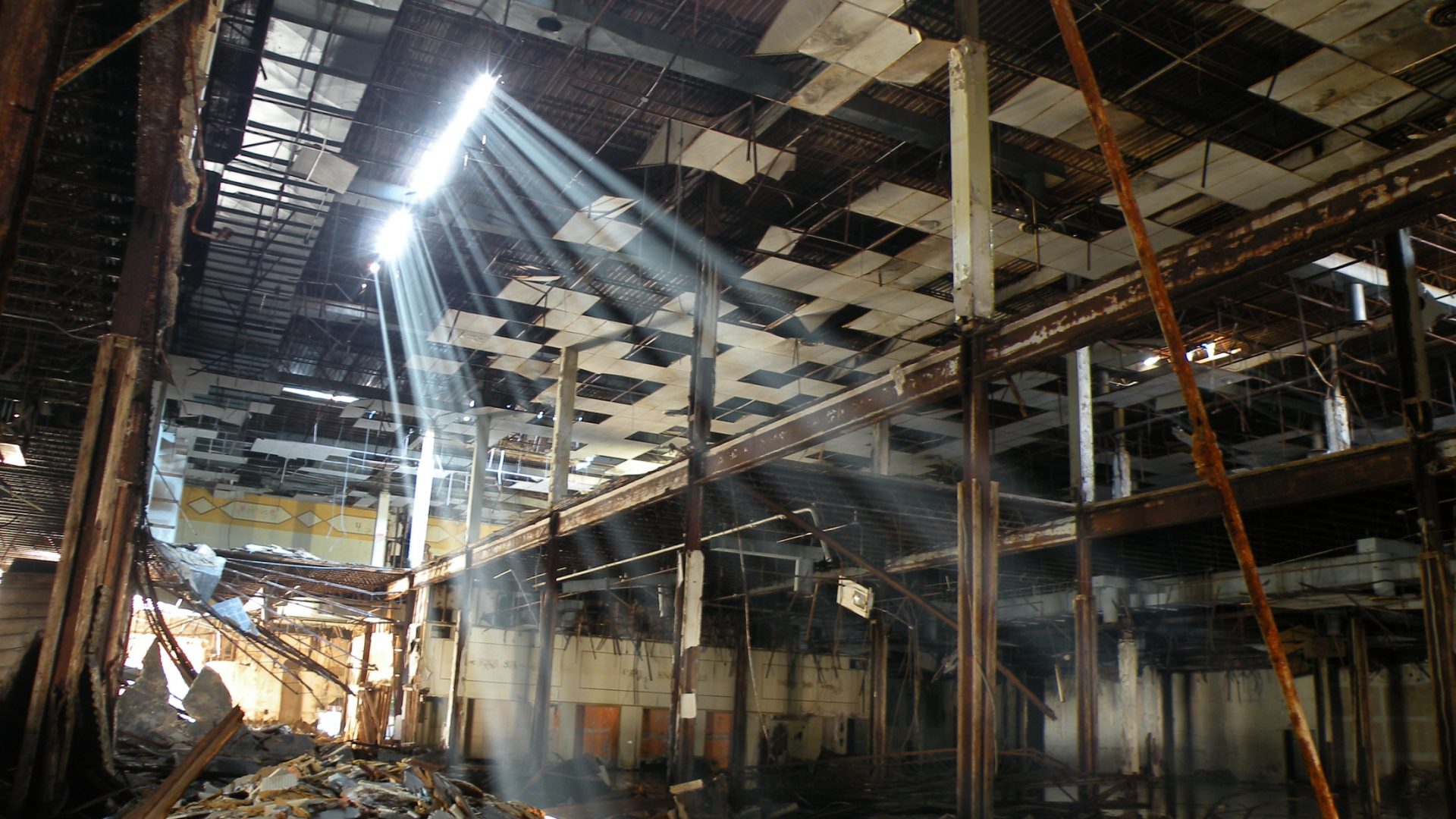| Origins | Settled by Conrad Sulzer in 1836 and annexed in 1889 |
|---|---|
| Area | Far North Side |
| Boundaries | Foster Avenue on the north, Irving Park Road on the south, Lake Michigan on the east, Ravenswood Avenue on the west |
| Gangs founded | Thorndale Jag Offs, Uptown Rebels, Outlaw Bloods, |
| Gangs headquartered | Spanish Gangster Disciples, Gangster Disciples, Conservative Vice Lords, Four Corner Hustlers, Latin Kings, Black P Stones, Latin Eagles, Outlaw Bloods, |
Conrad Sulzer first settled this community in the Buena Park area at present day Montrose and Clark. The “Graceland Cemetery” that was built in 1860 was also designated to be a park like area for Chicagoans to come and enjoy the outdoor leisure of this park. German and Swedish immigrants fell in love with the area and began having regular outings on this land. Some even built farms on this land such as “Buena Park” in 1860 and “Cedar Lawn” in 1869 and the famous “Edgewater” in 1887.
The area that was named Edgewater was a higher-class subdivision as upper classes and middle classes of people moved here in the late 19th century and early 20th century.
The area, including Edgewater, was annexed into the city of Chicago in the year 1889, after this a major plan was put together to build the area up into a neighborhood loaded with shopping and entertainment to model after Broadway in New York City, hence, how Broadway Street came about and how the name “Uptown” was brought about. Uptown was the site of several shopping strips and theaters such as the Riviera, Aragon Ballroom, and the Uptown Theater in the first three decades of the 20th century. Several luxury apartments and mansions were constructed in the earliest part of the century, making the 1920s the best decade this neighborhood saw.
It was during the great black migration wave of the late 1910s that brought the first black community to Uptown as restrictive racial covenants allowed blacks to reside in the 4600-block area of Winthrop Ave which was between Leland to Kenmore on Winthrop. Blacks were confined to this small strip of land until the late 1940s when covenants were lifted.
The Great Depression era hit Uptown hard in the 1930s especially after Lake Shore Drive was extended to Foster Avenue making motorists bypass the shopping in Uptown as they headed for shopping in the more northern suburbs instead. Uptown struggled through the 1930s and by World War II the many luxury apartments were vacated by the wealthy then divided into smaller units for impoverished residents to move into. Landlords soon felt they no longer needed to maintain their properties due to lower class residents residing in their apartments and soon, the neighborhood began to deteriorate entirely.
By the 1950s Uptown became highly attractive to poor southern migrants and impoverished Native Americans that could not afford to live anywhere else. The State of Illinois also created halfway houses among the various dilapidated apartment complexes for the mentally ill that were trying to assimilate back into society. Uptown soon gained the reputation as “Hillbilly Heaven” as a slum for hillbillies and a place full of destitution and poverty, this reputation was not too far from the truth. Even though Uptown became a blighted and very impoverished place in the 1950s it was not a dangerous neighborhood with high crime. There were several greaser gangs on these streets, but it was not one of Chicago’s bad neighborhoods.
In the early 1960s Uptown was now affordable enough for impoverished black and Hispanic people to take up residence in this community which often set off ill feelings from the dominating gang in the area the Thorndale Jag Offs. The Jag Offs were more concentrated in the Edgewater area, and they often did not patrol anywhere south of Foster Ave. Almost all the Hispanic and black community was south of Foster Avenue out of TJO territory. A new wave of African American and Hispanic migration began in 1962 which was the same year the TJOs assembled but the TJOs were only concerned with the affairs of the part of Uptown that would become Edgewater.
By the year 1969 residents noticed a sharp increase in crime in the community and some of the community blamed increased gang activity. Hispanic and African American migration increased in the 1968 and 1969 years as some racial conflicts would begin. A very large portion of Uptown if not most of Uptown was racially tolerant and blacks, Hispanics and whites lived in harmony as all three were struggling financially equally. Many people of Uptown lived in rented property and suffered from neglectful slumlords that did not maintain their properties. This led to protests in the community in 1968-1969 against slumlords that would go on well into the 1970s.
In these later 60s year Senn High School began to buss in African American students from disadvantaged areas of the south side and west sides. Sometimes these students had gang ties to gangs like the Conservative Vice Lords, Black P Stones and Devil’s Disciples. Gangs and racial conflict was very intense in the late 60s and early 70s at Senn.
By 1969 the far northern side of the community in the Argyle area down to Uptown Square and Clarendon Park experienced the most African American migration. Among several apartment complexes many black families settled here in the late 1960s. Alongside this migration wave came the Conservative Vice Lords, Black P Stones, and Black Gangster Disciples in 1969. The Black Gangster Disciples settled in the oldest part of the black community at Lawrence and Winthrop. Black P Stones and Conservative Vice Lords began gathering in the area of Agatite and Hazel in 1969. The Conservative Vice Lords began in this area then Black P Stones would settle north by Winona Street and Kenmore to Sheridan in the most northern part of Uptown. The Conservative Vice Lords were the first significant gang to settle in Buena Park area.
In 1969, the Latin Kings organization arrived on these streets to assist the growing Hispanic community with racial issues, they faced with bitter southern Appalachian greaser gangs. The Latin Kings came to preach to the growing Hispanic community about coming together to fight back against oppression of the Hispanic people and Uptown was a place where Latin Kings could be needed. The Latin Kings settled at Winthrop and Ainslie. The Harrison Gents also migrated to Uptown in 1969 to support both the Hispanic and black community and within no time both Harrison Gents and Latin Kings would support the black and Hispanic community. Several whites joined both gangs as these groups were not restrictive about race if the white members were willing to fight for their causes it was more than acceptable for whites to join. The Harrison Gents settled one block from the Latin Kings at Kenmore and Ainslie and the two groups became tight allies from the start in 1969. Both gangs happened to settle very close to the original African American community on Winthrop Ave. The Harrison Gents had a strong presence just one small block from the early African American settlement at Winthrop and Lawrence.
It became clear that the Uptown Square section of Uptown was the first area that African Americans and Hispanics were settling in the 1960s and the settlement would soon grow into Sheridan Park and Clarendon Park and Lakeside area. These areas also housed the most impoverished whites and Native Americans that lived in heavy poverty and blight.
By 1969, as Harrison Gents and Latin Kings were arriving the Gaylords came to Uptown bonding with youth that were fed up with racial change and the neighborhood gangs. The Gaylords represented youths that had more conservative views that wanted their neighborhood to remain mostly white. This all led to Gaylords settling Sunnyside and Magnolia, Wilson and Dover and Lawrence and Broadway in 1969. The Gaylords became very popular with mostly white youths in the Sheridan Park area.
In the same Sheridan Park area, another group of youths south of Sunnyside Ave felt the same way as Gaylords. These youths were more of a home-made group than the Gaylords that migrated here. These youths formed the Uptown Rebels that dominated the area near Graceland Cemetery. Many of these youths resided in an apartment complex for very impoverished Appalachian white youths at the intersection of Montrose and Malden. The Uptown Rebels would become close allies with the Gaylords by 1969.
Starting in 1969 many residents experienced heavier blight than ever, heavy gang activity, and high crime. This drove some white flight; however, most of Uptown’s white population was in a state of severe poverty of close. This meant white flight was not an option for many white families. Many of these families were frustrated by the increased black and Hispanic migration and sided with the Gaylords and Uptown Rebels; however, a great number of residents supporting the Gaylords and Uptown Rebels were African American, Hispanic and Native American. It almost didn’t matter about race it more meant whether a resident supported cultural and social change or wanted the neighborhood to remain it had been.
In the year 1970 the infamous “4848” building was constructed at 4848 North Winthrop Avenue, which was a 280 unit 19 story high rise apartment building that was ran by the U.S. Department of Housing And Urban Development. Of course, this being a government ran building that provided exclusive section 8 residents with housing would result in horrible neglect and mismanagement. This tower was conveniently located at Lawrence and Winthrop, just one block from the first black community established decades before. The Black Gangster Disciples would control the most historic part of the black community that now needed great assistance. This tower alone helped the Black Gangster Disciples established themselves as a major part of this community.
Drugs took over this tower of misery as Chicago police reported in 1991 that this tower had a long standing drug operation by street gangs and the building had a supply of automatic weapons (Chicago Tribune J. Linn Allen, June 22, 1993). The building was finally sold and renovated to become the United Winthrop Tower Cooperative.
In the 1970s Uptown became one of the largest homes to Chicago’s homeless community as these streets became saturated with homeless sleeping in streets, gutters, abandoned buildings and abandoned vehicles. Many other homeless lived in their vehicles and some families even lived in motor vehicles.
In the 1970s Uptown became attractive the southeast Asian migrants as they settled in the Argyle Street area from Sheridan to Leland. By 1975 this area became known as “Vietnamese Town.” By the late 1970s Argyle Street by Sheridan and Leland became bustling with the Vietnamese and Cambodian culture as several Vietnamese owned restaurants and businesses opened.
During the 1970s Uptown saw the worst years of blight as the crime rate continued to climb to new heights Uptown was not used to but would soon adapt to by the later 1970s. Uptown now became one of Chicago’s most dangerous neighborhoods with heavy gang activity. The gangs may have added to the crime rate but in these times, gangs watched over their neighborhood streets and made sure residents were safe from outside attackers. In heavily gang-controlled areas of the community residents were often safer than in areas where gangs didn’t control as tightly.
In the 1970s and 1980s there was a large cluster of blighted, low-income apartments that stretched from Clark Street to Clarendon Avenue and from Lawrence Avenue to Montrose Avenue. Within these clusters of bombed out, ran down apartment for the poor were Uptown Rebels, Gaylords, Harrison Gents, Brazers, Vice Lords, Gangster Disciples and Latin Kings. Uptown Rebels, Gaylords, Gangster Disciples, Vice Lords arrived in 1969 within these apartments. Brazers would arrive in 1975 near Clarendon Avenue and the Latin Kings would move into Montrose and Hazel apartments in 1978. These apartments were rough and dangerous with many shooting and Vice Lords were especially known for drug dealing at Agatite and Hazel. These apartments were some of the roughest in Chicago and these buildings have either been torn down or heavily rehabbed to become unrecognizable.
By the early 1980s Uptown had heavily depreciated in value to the point where property was some of the cheapest in the city. Uptown was also the last neighborhood in the city where whites lived in blighted buildings and were far below the poverty line. In the year 1981 the Brazers arrived in this neighborhood in the Sheridan Park area as they instantly clashed with Gaylords. The Brazers dominated Chase Park area of the East Ravenswood area. In 1983 the Spanish Gangster Disciples arrived in the Uptown Square area battling with Latin Kings. Both Spanish Gangster Disciples and Brazers would conflict heavily with Latin Kings. Both gangs heavily united with the Black Gangster Disciples. Black P Stones, Gaylords, Conservative Vice Lords and Uptown Rebels had a unity under the People alliance in the 1980s.
In the 1980s the Latin Eagles arrived in Uptown and now dominated the entire southern part of Uptown from Buena Ave/ Berteau Ave to Irving Park Road. The Latin Eagles ended up at heavy odds with Latin Kings, Conservative Vice Lords and Uptown Rebels.
In the mid-1980s Asian youths from the Vietnamese Town area began to feel the pressure and repercussions of gangs in the neighborhood. Many youths migrated here from the state of California in the Los Angeles area and were familiar with Los Angeles area gangs. One such gang southeast Asian youths from Los Angeles knew well was the Bloods street gang. In the mid-1980s Asian youths worked with Black P Stones since Vietnamese Town was located in Black P Stone turf. An arrangement was made between the Bloods street gang and Black P Stones to put a Asian street gang in this area associated with both gangs known as the Outlaw Bloods. There was another Asian gang known as the Loco Boys that would now ally with Outlaw Bloods and would eventually join their ranks. This Sheridan and Leland area became the hub of the most dangerous and most hardcore Asian gang element in the city.
By the later 1980s white flight became stronger among the impoverished white community as these families could now afford the suburbs. As these families left the area the Gaylords shrunk in size and the Uptown Rebels left these streets entirely. Gang violence was escalating to some of the worst years in the later 1980s as drug trafficking became a larger problem. Since the 1970s Uptown was a major site of drug trafficking and prostitution but by the late 80s some of the worst years had arrived.
The 1990s saw some of the worst gang violence in Uptown’s history as property values fell to bottom rates by the mid-1990s making this neighborhood ideal for yuppies to purchase and fix up. This began a new era in Uptown as the community quickly caught on as a new trendy place to live. This caused an increase in police presence now that higher income Chicagoans were living here. During the course of the 2000s decade Uptown went through a major gentrification wave that altered the neighborhood entirely removing almost every piece of blight and vacant areas. Many groups of the gangs could no longer afford this neighborhood and left the area in the 2000s. Uptown now became the site of a trendy community with several trendy restaurants and businesses. A positive effect of this new migration was not only that blight vanished, also crime rates plummeted making Uptown one of Chicago’s more dangerous areas to one of Chicago’s safer communities. Many new buildings were built over once vacant lots and over the land that once housed blighted buildings. These new buildings are high rent apartments and condos targeting Chicago’s more upper income classes.
Uptown has become completely unrecognizable due to so much urban renewal but the gangs that have always existed remain on these streets either visibly or reclusive.
In the 1970s Latin Kings, Harrison Gents, Gaylords, Black Gangster Disciples, Conservative Vice Lords and Black P Stones dominated Uptown.
In the 1980s Latin Kings, Harrison Gents, Gaylords, Black Gangster Disciples, Conservative Vice Lords, Black P Stones, Brazers and Spanish Gangster Disciples dominated Uptown.
In the 1990s to present years Uptown is dominated by Latin Kings, Gangster Disciples, Conservative Vice Lords, Black P Stones, Spanish Gangster Disciples, Latin Eagles and Four Corner Hustlers.
Those of you from the young urban professional class may be interested to know these significant gangs have walked these streets over time:
Uptown Rebels Established 1969-Late 1980s
Sunnyside to Montrose, Clark to Clifton
Outlaw Bloods mid-1980s-2000s
Broadway to Sheridan, Argyle to Leland
Black P Stones Established 1969-present years
Foster to Lawrence, Winthrop to Sheridan
Brazers Established 1975-1996
Wilson to Sunnyside, Clarendon to Hazel to Established 1975-1981
Ainslie to Leland, Beacon to Paulina (Chase Park) Established 1981-1996
Harrison Gents Established 1969-1990s
Sheridan & Leland 70s, 80s, 90s
Lawrence & Winthrop 80s, 90s
Argyle to Ainslie, Sheridan to Winthrop Established 1969-1990s
Gaylords Established 1969-present years
Lawrence to Sunnyside, Dover to Broadway Established 1969-present years
Latin Eagles 80s-present years
Berteau/Buena to Irving Park Rd, Ashland to Clarendon (Ghost Town, EMs) 80s-present years
Los Be Be Stones Late 90s-2000s
Sunnyside & Clark Late 90s-2000s
Simon City Royals Established 1976-1979
Leland & Kenmore Established 1976-1979
Latin Kings Established 1969-present years
Foster to Lawrence, Ashland to Winthrop Established 1969-present years
Montrose & Hazel 70s-present years
Agitate & Hazel
Berwyn to Argyle, Broadway to Sheridan (The Uptown Triangle)
Lawrence to Sunnyside, Paulina to Clark (Chase Park) 1996-present years
Four Corner Hustlers 90s-present years
Leland to Sunnyside, Sheridan to Clarendon (Lil 4 Mobb) 90s-present years
Windsor & Hazel (Shared with Conservative Vice Lords) 90s-present years
Young Stylers Established as Young Stylers 1979-1983
Ashland & Foster Established as Young Stylers 1979-1983
Gangster Disciples Established 1969-present years
Lawrence & Sheridan (Uptown Ghetto Gangsters)
Lawrence & Winthrop (4848)
Argyle to Lawrence, Broadway to Sheridan (L Dubb)
Leland to Montrose, Malden to Clifton (TFG) Established
Spanish Gangster Disciples Established 1983-present years
Broadway & Cuyler (Uptown Green) Established 1983-present years
Ainslie to Lawrence, Kenmore to Broadway Established 1983-present years
Thorndale Jag Offs (Of Edgewater previously Uptown) Established 1962-1990s
Foster to Montrose, Kenmore to Sheridan Established 1962-1990s
Conservative Vice Lords Established 1969-present years
Sunnyside to Hutchinson, Sheridan to Clarendon (Uptown Lords)
Wilson to Montrose, Broadway to Clarendon (Uptown Lords) Established 1969-present years
Agatite & Hazel Established 1969-present years
Windsor & Hazel (shared with Four Corner Hustlers)
Leland & Magnolia (Shared with Traveling Vice Lords)
Traveling Vice Lords 90s-present years
Leland & Magnolia (Shared with Conservative Vice Lords) 90s-present years
Imperial Insane Vice Lords 90s
Leland & Beacon 90s









































